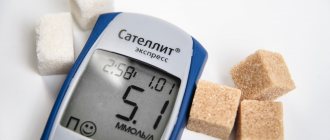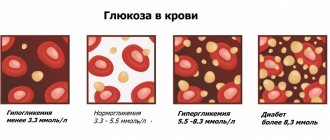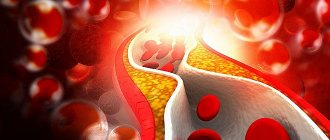Endocrinologist
Fedorov
Elena Anatolyevna
10 years of experience
Endocrinologist
Make an appointment
People diagnosed with diabetes should be aware of hypoglycemic syndrome. This is a condition that occurs when blood sugar levels drop to critically low levels. Hypoglycemia and manifestations of symptoms are variable. The phenomenon can be dangerous to health and life. A drop in sugar (glucose) levels occurs when you skip a meal or after intense physical activity. The deterioration in health occurs suddenly. It is necessary to carefully monitor your condition and know measures to prevent an attack.
How does low blood sugar affect the body?
Normal blood sugar levels may fluctuate throughout the day, but not significantly.
But blood sugar levels that are too high or too low can cause health problems. Low blood sugar, or hypoglycemia, occurs when blood sugar levels become too low. And a recent article notes that hypoglycemia most often occurs due to certain medications, especially for diabetes. However, there are other possible reasons.
In this article, we'll learn what low blood sugar is, how it affects the body, and when to see a doctor.
What is low blood sugar?
We all need blood sugar to provide energy to our cells.
Hypoglycemia, also known as low blood sugar, is a condition in which the concentration of sugar in the blood falls below the normal range. This may interfere with the normal functioning of the body.
Doctors usually measure blood sugar levels in milligrams per deciliter (mg/dL). In general, healthy blood sugar levels range from 60 to 140 mg/dL.
The National Institute of Diabetes and Digestive and Kidney Diseases (NIDDK) notes that people with diabetes should aim for blood sugar levels of 80-130 mg/dL before meals. 2 hours after starting a meal, your blood sugar should be below 180 mg/dL.
Preparation
When preparing for a blood test for hormones, children should follow the following recommendations:
- The study is carried out on an empty stomach, so it is necessary to refuse food at least 8 hours in advance;
- There is no need to brush your teeth in the morning, since children's toothpaste often contains sugar, which can negatively affect the reliability of the research results;
- A child should not be tested for hormones during infectious diseases.
If the child is currently taking any medications, then it is necessary to inform the specialist who will perform the procedure.
Symptoms of hypoglycemia
Symptoms of mild to moderate hypoglycemia include:
- confusion
- difficulty concentrating
- anxiety
- headache
- cold sweat
- shiver
- rapid pulse
More severe cases may include seizures, loss of consciousness, or inability to eat or drink.
Some people experience several symptoms when their blood sugar levels drop, while others only experience one or two.
Symptoms of hypoglycemia
People who do not have diabetes begin to feel unwell when the readings drop to 3.3 mmol/L. Experienced diabetics usually have elevated sugar levels. Their body reacts more vividly to a sharp decrease in indicators. Symptoms of hypoglycemia, conditionally, are divided into three groups, depending on the severity of the manifestation.
Mild symptoms:
- cephalgic syndrome (headache), dizziness;
- hyperhidrosis (excessive sweating), sometimes with cold sweat;
- increased psycho-emotional excitability, fussiness, unreasonable anxiety;
- low BP (blood pressure);
- astheno-vegetative syndrome (weakness, decreased ability to work);
- rapid, rhythmic contractions of the muscle fibers of the legs and arms (trembling or tremor);
- polyphagia (increased appetite);
- decreased visual acuity.
Symptoms of moderate hypoglycemia:
- psycho-emotional instability (irritability and aggressiveness are replaced by apathy);
- lack of concentration;
- asthenia (neuropsychological weakness);
- increased heart rate (tachycardia);
- speech dysfunction (slow speech);
- ataxia (impaired coordination);
- decreased sensory sensitivity;
- pale skin;
- dysphagia (impaired swallowing function);
- involuntary muscle contraction (convulsive syndrome).
Symptoms of a serious condition: lack of sensory perception, severe paroxysmal manifestations of convulsions, dilated pupils, stuporous state (decay of brain activity), decreased natural reflexes, dementia syndrome (dementia), short-term loss of consciousness (fainting). In the absence of medical assistance, a coma occurs, which can lead to death.
Additionally
In children, hypoglycemia is accompanied by the smell of ammonia from the mouth, as ketone bodies (acetone) appear in the blood. There is a reflex release of stomach contents through the mouth. A decrease in blood glucose can occur during night sleep. In this case, hypoglycemia can be suspected based on the following manifestations:
- restlessness in sleep, “throwing” around the bed;
- sleepwalking (committing any unconscious and uncontrollable actions in a dream);
- hyperhidrosis;
- screaming and moaning associated with nightmares.
After waking up, a patient who has experienced a hypoglycemic attack complains of headaches, nausea, and weakness. Signs of confusion may occur.
Low Blood Sugar: Causes
The NIDDK notes that on a short-term basis, a sugar crash occurs when the level of physical activity increases beyond normal, skips a meal, drinks alcohol without a snack, or vomits.
Sugar levels can also drop if you don't have enough carbohydrates.
In most cases, blood sugar levels drop too low due to diabetes treatment—for example, if a patient has taken too much insulin. Sometimes the body naturally produces too much insulin, which can also cause a decrease.
Medicines for other illnesses may also lower your sugar levels as a side effect.
In addition, low blood sugar can be caused by liver diseases such as hepatitis or kidney problems.
Reasons for low glucose levels
When figuring out why sugar levels decrease, it is necessary to take into account the presence of chronic diseases, primarily diabetes. The development of hypoglycemia in diabetics is provoked by the following factors:
How to measure blood sugar correctly?
- Incorrect insulin therapy for type 1 diabetes. In most cases, this is an excess of the permissible dosage of short and ultra-short insulins (Actrapid, Novorapid).
- The presence of a hormonally active tumor (insulinoma). The pancreatic tumor is capable of producing insulin on its own. Excessive amounts of the hormone in the body leads to a decrease in sugar.
- Taking inappropriate doses of glucose-lowering tablets for type 2 diabetes. Preparations based on sulfonylurea derivatives tend to accumulate and be slowly excreted from the body (Maninil, Tolbutamide, Glimepiride, Glirid, Diabeton).
- Untimely eating. After an insulin injection, a diabetic patient needs to eat so that the body produces the necessary glucose and the drug delivers it to the tissues and cells.
- Physical activity that exceeds the capabilities of a diabetic. In the insulin-dependent type of the disease, exercise should be accompanied by the consumption of complex carbohydrates. Without carbohydrate support, blood sugar drops rapidly.
- A disproportionate combination of components of complex treatment (medicines, food and traditional medicine that lower glucose). Excessive enthusiasm for alternative therapy together with treatment with glucose-lowering drugs can provoke an overdose.
- Uncontrolled intake of alcoholic beverages. Ethanol inhibits the breakdown of food, so the production and resorption (absorption) of glucose slows down.
Important! Heavy alcohol intoxication in a diabetic patient can cause a hypoglycemic coma, since the person does not feel symptoms of a drop in sugar.
In addition to diabetes mellitus, low glucose levels can be observed in the decompensated stage of chronic liver and kidney diseases, in the postoperative period after surgical intervention in the digestive tract, against the background of acute or chronic heart failure, in hypothalamic-pituitary diseases, in particular, in cases of impaired hormone production (adrenocorticotropin, prolactin, somatotropin, etc.), with insufficient synthesis of corticosteroids (adrenal hormones).
Reasons for low sugar in people who do not suffer from these diseases:
- chronic alcoholism;
- excessive sports activity or physical labor;
- poor nutrition (overeating after long-term abstinence from food);
- fasting (including therapeutic fasting);
- menstrual phase of the cycle in women;
- incorrect ways of dealing with extra pounds (fad for diets that do not correspond to health conditions);
- the body’s reaction to the intake and rapid processing of large amounts of simple carbohydrates (response hypoglycemia).
Unstable glucose levels are often detected in pregnant women. In this case, the main reasons for the decrease in sugar are the hyperactive production of insulin by the pancreas, poor nutrition (lack of vitamins, minerals, carbohydrates), and insufficient glucose production to supply two organisms. In a newborn baby, low blood sugar can be caused by the following reasons:
- hypoxia (oxygen starvation) occurred during childbirth;
- the baby was born prematurely (premature delivery);
- the child has been diagnosed with an intrauterine infection;
- the mother has diabetes or was diagnosed with gestational diabetes during pregnancy.
A decrease in glucose in preschool and school-age children indicates an unbalanced diet against the background of irrational physical activity and neuropsychological instability. McCurry syndrome, otherwise idiopathic familial hypoglycemia. A rare disease diagnosed in a male child under 2 years of age. The cause is a hereditary pathology of the enzyme that breaks down insulin (insulinase).
Consequences of hypoglycemia for the body
If low blood sugar is not addressed and symptoms become more prolonged, the condition can lead to several short- and long-term consequences.
Short term effects
In severe cases, short-term complications may occur which include:
- brain bleeding
- acute cardiovascular disease
- cognitive impairment
Long term effects
Low blood sugar has few direct links to critical long-term consequences, but it can increase a patient's vulnerability to other conditions such as heart disease.
For example, an earlier study found that participants with low blood sugar due to type 2 diabetes had an increased risk of developing heart disease and blood vessel problems.
Hypoglycemia may also increase the risk of other conditions, including:
- eye disease
- kidney disease
- nerve damage
In severe cases, nerve cells may die due to lack of glucose. When the nerves that control internal organs are damaged, the body can develop autonomic neuropathy.
With this disease, the patient loses the ability to detect blood sugar and may not experience any symptoms. He may not know that he has low sugar, which prevents early intervention in the course of the disease. This increases the risk of developing severe hypoglycemia.
Information about diagnosis and treatment
It is quite simple to notice and determine a change in condition, which is due to characteristic symptoms. For this reason, diagnosis of hypoglycemia is based primarily on an initial analysis of the patient’s condition. After the examination, a number of tests and studies are prescribed to clarify the etiology and diagnosis:
- blood and urine tests;
- study of blood glucose concentration;
- biochemical blood test with determination of albumin and protein;
- urine glucose test;
- insulin level studies;
- assessment of the function of the thyroid gland, pituitary gland and pituitary-adrenal system;
- Ultrasound of the abdominal organs.
Impact on different body systems
Hypoglycemia can affect several body systems in different ways.
Digestive system
Extremely high or low blood sugar can cause a condition called gastroparesis. Low sugar affects the transmission of signals in the vagus nerve, which normally stimulates gastric emptying.
Gastroparesis causes problems with the digestive system because it can cause food to sit in the stomach for too long before reaching the small intestine. Short-term symptoms of this condition include abdominal pain, nausea and vomiting.
Endocrine and circulatory systems
Severely low blood sugar can also affect the endocrine and circulatory systems, damaging nerves that transmit important information.
The effects on the endocrine system are largely due to the neuroendocrine network, which controls the body's response to low sugar.
The circulatory system responds to low blood sugar by reducing the amount of circulating insulin.
central nervous system
The central nervous system (CNS) includes the brain and spinal cord. Blood sugar is the primary source of energy, so it needs your blood sugar levels to be above a certain level.
Thanks to this, the central nervous system quickly responds to a sharp drop in blood sugar levels, activating various regulatory measures until glucose levels are restored.
Diabetes mellitus in children - symptoms and treatment
Complications of diabetes mellitus in children are divided into acute and delayed.
Acute complications are associated with an unstable course of diabetes mellitus and a sharp decompensation of carbohydrate metabolism. This can happen at any stage of the disease due to stress, poor diet or treatment tactics, acute, chronic infections or other concomitant diseases.
The fact is that children and adolescents often face psychological problems regarding their illness, especially type 1 diabetes. Because of this, they may deliberately break their diet or stop taking insulin, unaware of other serious problems that may occur. The result is either hypoglycemia with the possible development of hypoglycemic coma, or significant hyperglycemia with diabetic ketoacidosis or hyperglycemic hyperosmolar status.
Hypoglycemia is the most common complication of type 1 diabetes. In the case of type 2 diabetes, it may occur when insulin therapy or treatment with sulfonylurea derivatives is necessary.
Children, especially at an early age, are more sensitive to low blood glucose levels than adults, so they are at higher risk of developing hypoglycemia. In this case, symptoms appear against the background of higher glucose levels compared to adults, and the rate of development of severe hypoglycemia, requiring urgent intervention, is higher [1].
Hypoglycemia in children can manifest itself as tremors, tachycardia, and increased sweating. Sometimes the symptoms of neuroglycopenia come to the fore: headache, drowsiness and impaired concentration. Young children with hypoglycemia may notice behavior changes such as angry outbursts, restlessness, irritability, or apathy.
Diabetic ketoacidosis occurs against the background of hyperglycemia due to a lack of insulin or increased concentrations of counter-insulin hormones. Diabetes mellitus is often first diagnosed in this condition: in 88% of children with type 1 diabetes and 10% of children with type 2 diabetes [1][12].
The complication begins in different ways: from a mild course with minor dehydration to a severe course with serious dehydration and loss of consciousness.
Symptoms of diabetic ketoacidosis include dry skin, increased thirst, tachycardia, rapid breathing or Kussmaul breathing - rare, deep, with noisy inhalation and sharp exhalation, the smell of acetone on the breath, nausea, vomiting, abdominal pain, confusion or loss of consciousness.
Laboratory signs include:
- blood glucose level is more than 11 mmol/l;
- increased concentration of ketone bodies in the blood and urine;
- pH level is less than 7.3;
- bicarbonate level is less than 15 mmol/l [1][2][7].
Hyperglycemic hyperosmolar status can occur in neonatal diabetes mellitus, type 1 and type 2 diabetes. Manifested by convulsions, aggression, loss of consciousness.
Laboratory signs include:
- blood glucose level from 33 mmol/l and above;
- a slight increase in the concentration of ketone bodies in the blood and urine;
- pH level below 7.3;
- bicarbonate level is below 15 mmol/l [1][2][7].
Long-term complications of diabetes begin in childhood but may appear later in adulthood. Such complications include diabetic polyneuropathy, retinopathy and nephropathy.
Diabetic polyneuropathy is associated with damage to peripheral and autonomic nerves [14]. It occurs due to metabolic disorders and damage to small vessels - microangiopathy.
Neuropathy is the most common delayed complication in children with diabetes. At this age, it is usually in the preclinical or primary clinical stage.
With peripheral neuropathy, the lower extremities are most often affected. This may cause numbness, tingling, burning in the fingers and toes, and short-term cramps. Even light touches can cause discomfort or pain.
Damage to the autonomic nerves disrupts the functioning of internal organs: the heart, gastrointestinal tract, urogenital system, etc. Therefore, the symptoms of autonomic polyneuropathy are numerous and varied. They depend on which organ the affected nerve fibers are responsible for innervating. The child may be bothered by tachycardia at rest, decreased blood pressure when changing body position, heartburn, stomach pain, difficulty urinating, etc.
Diabetic retinopathy is associated with damage to the retinal vessels. It can appear in children within a year after the onset of the disease, and sometimes only with insulin resistance.
In the initial stages, the complication does not manifest itself in any way. As the disease progresses, the child may have complaints of deteriorating vision, the appearance of “spots”, dots or veils before the eyes, difficulty reading, and sometimes pain in the eyes after visual stress.
In 4% of children, diabetic retinopathy leads to blindness within 3-5 years [22]. Severe retinopathy with vision loss develops more often in adolescents than in adults [1].
Diabetic nephropathy , which occurs during childhood or adolescence, is a leading cause of disability and death in adult patients with diabetes. In children, this complication is usually in the preclinical stage, so doctors often underestimate the presence of this problem.
Preclinical diabetic nephropathy can be identified by regularly checking laboratory parameters that may indicate diabetic kidney damage. These indicators include the level of albumin and creatinine, glomerular filtration rate, etc. For example, incipient nephropathy in children and adolescents is manifested by microalbuminuria - when the level of albumin in morning urine is 30-300 mg/l.
In addition to polyneuropathy, retinopathy and nephropathy associated with damage to small vessels, children develop initial manifestations of macroangiopathies , such as atherosclerosis of the coronary arteries. Most often, such complications are associated with poor control of blood glucose levels.
Despite the fact that symptoms of delayed complications rarely appear in childhood, functional impairment begins at this time. The risk of complications increases with puberty. During this period, the child undergoes endocrine changes, the level of growth hormone and sex hormones increases. As a result, insulin sensitivity decreases and insulin resistance occurs. In addition, growth hormone is a counter-insular hormone, so the need for insulin in adolescents increases significantly and can reach up to 2 U/kg [23].
Treatment
If you are experiencing symptoms of low sugar, you can quickly get rid of them by consuming foods or drinks that quickly raise your blood sugar.
Options include a glass of milk or orange juice and carbohydrate-rich foods such as a sandwich.
If 15 minutes have passed and your symptoms have not changed, you should eat or drink some more.
In cases where your blood sugar levels drop very severely, you may become drowsy, confused, and unconscious. If this is a recurring event, hypoglycemia should be treated with glucagon injection.
However, if a glucagon injection is ineffective or unavailable, emergency medical help should be called immediately. Symptoms may become more severe, leading to seizures or coma.
Prospects
If the cause of low blood sugar is temporary—for example, after skipping a meal—getting glucose through food and sugary drinks should begin to improve the condition almost immediately.
However, hypoglycemia cannot always be treated with food and drink. If you experience low blood sugar frequently and severe hypoglycemia develops, your doctor may provide a glucagon emergency kit, which includes an injection if necessary.
In this case, patients should wear a medical alert bracelet so that others know what to do in case of an emergency.
All the necessary information about the disease
A person’s condition directly depends on the level of glucose in the blood. If the values drop to 1.9-2.2 mmol/l in women and to 2.5-2.8 mmol/l in men, a hypoglycemic state occurs. In people with diabetes, such jumps in indicators are not uncommon. This poses a particular danger to the brain. He is the most sensitive in this aspect. Glucose levels are regulated in the body by a number of metabolic processes. In a healthy person, hypoglycemia does not occur because the liver contains a sufficient amount of glycogen.
Conclusion
Low blood sugar, also called hypoglycemia, can be a temporary condition that occurs if you skip meals for a while or exercise more intensely than usual.
Low sugar causes mild to moderate symptoms, including dizziness, hunger and weakness, and can be quickly treated by consuming sugary foods or drinks.
Certain conditions, such as diabetes, can also cause low blood sugar. In such cases, symptoms may be more frequent and intense. Severe hypoglycemia has serious consequences.








